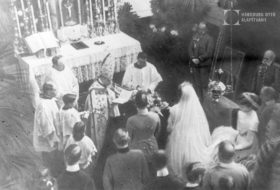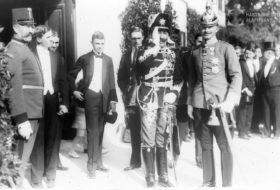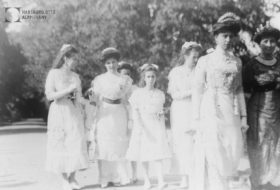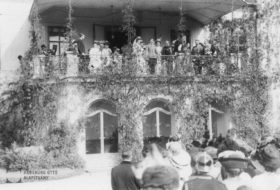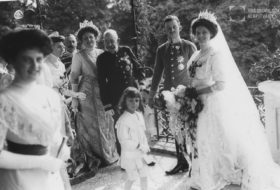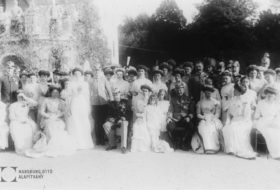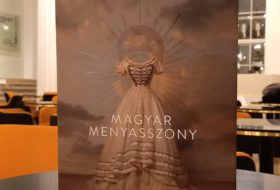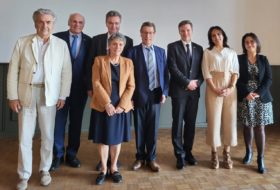This year marked the 100th anniversary of the death of the last Austrian Emperor and King of Hungary, Charles von Habsburg, whom Pope John Paul II beatified in 2004. The liturgical day commemorating the saintly king was 21 October, coinciding with the anniversary of his marriage. With this decision, the Roman Catholic Church wished to draw attention to his exemplary married life and one of the possible paths to sainthood.[1]
Zita was born as a princess of the Bourbon-Parma family, and Charles of Habsburg-Lothringen was the grandson of Franz Joseph’s brother, Charles Louis. Austrian historian Erich Feigl described this important day of their lives as “the last grand wedding in Europe”.[2] We think it is essential to underline that it was a marriage of love, not a marriage dictated by politics. A journalist from the Budapest newspaper wrote this about the occasion: “this glorious, fairy-tale wedding is the happy ending of a romantic love story”.[3] With the use of the press of the time and published scientific literature, this article aims to be a brief, pictorial summary of the big day. There are plenty of pictures of the event for posterity, as numerous photographers and cinematographers attended the event.
They met as children in the Chateau of Schwarzau, owned by the Bourbon-Parma family, but the defining encounter occurred in 1909 at the famous spa of Franzensbad[4]. Two years later, on 13 June 1911, they became engaged in Zita’s birthplace, the Pianore Palace, in a small family circle.
The betrothal was reported in several Hungarian newspapers, and preparations began immediately after the engagement.[5] The couple signed a marriage contract, which the commissioners drafted for several weeks. During this time, the Duchess studied Hungarian and Czech at the Schwarzau Castle and toured Vienna, where she had her wedding dress made in a fashion salon on Kärtner Strasse. These were exhibited before the wedding so that the public could inspect them and the press could report the contents of the finished chemise in detail. Charles was at the Brandeis barracks but visited his bride several times and gifted her a necklace of twenty-two rows of pearls as a wedding present.[6]
To honour the occasion, the Parma family had the castle renovated to make it a fitting venue for the wedding. They renovated drawing rooms, replaced the benches in the chapel of the castle with chairs to provide more seating for guests, and even installed a special telephone to receive congratulations from those who were unable to attend the big day. Around the castle, houses in the villages were decorated with garlands and flags, a special post office was set up in the park to receive wedding gifts and telegrams, and chancel arches were placed on the road to the castle. [7]
A separate salon in the castle was used to keep the arriving wedding gifts. Archduchess Maria Josepha presented Princess Zita with a brilliant brooch, while Franz Ferdinand gave her a diamond ring set with rubies. Other gifts included a silver box, a porcelain coffee set, handicrafts, presents from various institutions and a Zita waltz composed by the court conductor. A memorable attraction was the bronze statue of Zita, which was transported by airship from the barracks in Vienna by the young aviation officers, who knew how interested Zita was in flying. Even more joyful was the photograph presented by the mayor of Franzensbad, which captured the square where the couple had walked so many times after the engagement and the locals christened Zita Square. Among the gifts, many point out the copy of Leonardo da Vinci’s portrait of Christ in Milan in an ornate frame, sent by Pope Pius X, for the original was placed in the Maria Delle Grazie chapel because Zita’s full name is Zita Maria Delle Grazie.
Some guests arrived several days before the wedding and stayed in the surrounding castles and villas. In attendance were King Frederick Augustus III of Saxon, Franz Ferdinand and his wife, members of the Habsburg, Parma, Bragança, Spanish Bourbon, Orléans, Liechtenstein, Saxe-Koburg, Wittelsbach, Württemberg families and descendants of several princely and count families. The Hungarian guests appeared at the event in Hungarian court dress, ‘díszmagyar’. On 20 October, the representative of Pope Pius X, Papal Major-Domo Gaetano Bisleti, arrived. In the afternoon of that day, the guests were entertained by a school choir of 800 people, followed by dinner and a soirée with the 67th Infantry Regiment’s orchestra. Afterwards, the villagers held a torch-light procession and fireworks, and the couple then concluded with a short carriage ride around the village. Charles also received his appointment as a Major that evening.
The wedding day’s events have been recorded in great detail for posterity. The colourful press reports recorded every detail. Kaiserwetter, in other words, bright sunshine, greeted the crowds of guests. The most eagerly awaited attendee at the wedding was the Emperor himself, Franz Joseph, of whom every surviving account has a special mention. The Emperor arrived by special court train and was greeted with a huge ovation, and the so-called ‘Emperor’s Gate’ was reopened after 30 years. [8] The small chapel of Schwarzau Castle was the venue for the nuptial ceremony. It is noted in several places that seventy gilded chairs awaited the participants, and a massive chair of honour for Franz Joseph was set up to the left of the altar.[9] The Pope’s representative, Papal Major General Gaetano Bisleti, celebrated the ceremony in French. According to reports, the bride’s dress was made of heavy satin (Duchesse) material with a three-metre-long fin, on which were sewn silver embroidered Bourbon lilies and orange blossoms surrounded by myrtle garlands. Zita’s four sisters held the long tail during the procession to the chapel. The waist part of the dress was made of the same lace worn by her grandmother, the Queen of Portugal, at her wedding, and a bouquet of myrtles was placed at the bust. Princess Zita’s hairstyle was simple, yet made glamorous by wearing a myrtle wreath with a lace Brussels veil that reached down to the fin. The headpiece was adorned with the diamond tiara that Franz Joseph had given Zita. [10] The groom wore his dragoon captain’s uniform, and on his chest hung the Order of the Golden Fleece, along with the military medal and the order of the King of Saxony. The couple’s wedding ring bore, next to their names, a line from the deeply religious Charles’ favourite prayer: ‘Sub tuum praesidium confugimus, sancta Dei Genitrix’.[11]
The ceremony ended with the blessing of Pope Pius X: “In the many bitter hours of life, which will surely not spare you, may your faith in God be your support and may happy family life always be your refuge”.[12] The newlyweds then received their congratulations in the castle, followed by the wedding lunch, where Francis Joseph toasted them: “The wedding which has filled us all with joy and which we have gathered here today to celebrate is a great joy and great satisfaction. Archduke Charles has chosen Princess Zita of Parma as his life partner. I salute him and his heart for this choice, and I welcome Archduchess Zita with inward joy as a member of the family of my house […]”. [13]
The meal is always a crucial part of a wedding ceremony. At the reception, delicacies such as venison dishes, roast lamb and turkey were served on golden platters. The menu was: ‘Creamy lettuce salad, wild rabbit puree St Hubert’s style, renaissance roast lamb, Parisian-style langoustine, roast turkey, seasonal salad, asparagus with butter, pineapple and strawberry ice cream, cheese, fruits, dessert.’ [14] The banquet preceding the wedding was plated in silverware. The preserved menu card was written in French, as was the longstanding custom of the courts. The ten-course meal included poultry (chicken, pheasant), veal loin, salmon, trout, artichokes, cheesecakes and fruits, served with a variety of delicious sauces. [15] Immediately after the dinner, the newlyweds sent a telegram to the Pope, thanking him for his blessing and wedding gift.[16] Shortly after Francis Joseph’s departure, they took a car and travelled to Wartholz Castle in Reichenau, where they spent a few days on their honeymoon.
It is reported that after the event, a limited number of commemorative coins were minted on the orders of Franz Joseph and distributed among the top aristocracy. On one side of the coin, the newlyweds were depicted with the inscription ‘Carolus Franciscus Josephus Archidux Austriae and Zita Bourbonica Ducissa Parmensis’. The two coats of arms were on the other side, with the inscription “In Memoriam Felicissimi Matroninii. Biac 21. Octobris 1911.”[17]
Charles and Zita’s marriage could only have lasted eleven years because the former monarch died on the island of Madeira at the age of 34. The couple had eight children. Their exemplary marriage and devotion to each other endured through difficult times and exile until Charles’ death. For half a century afterwards, Zita, dressed in mourning, raised their children and kept her husband’s memory alive.
Eszter Gaálné Barcs,
Beáta Vitos-Merza
[1] Iván Bertényi Jr: Charles IV (the Blessed). Korunk, 2016, 8, 56. http://epa.uz.ua/00400/00458/00550/pdf/EPA00458_korunk_2016_08_054-063.pdf (Date of download: 10.10.2022)
[2] “Le dernier grand mariage de l’Europe.” Erich Feigl, Zita de Habsbourg. Mémoires d’un empire disparu. Traduit par Jacques Denis et Georges-Albert Salvan. Paris, Criterion, 1991, 90.
[3] Budapest, 22 October 1911, 5.
[4] Františkovy Lázně (Ferenc Baths) is a bathing place in the Czech Republic.
[5] Pesti Hírlap, 6 June 1911, 16; Pesti Napló, 15 June 1911, 7; Friss Újság, 15 June 1911, 2.
[6] Az Ujság, 15 October 1911, 6.
[7] Pesti Napló, 21 October 1911, 8-9.
[8] The imperial gate commemorated the Emperor’s visit in 1881 and was reopened for the wedding. Emil Csonka: Zita története. Az utolsó magyar királyné. Munich, Új Európa, 1975, 56.
[9] Délmagyarország, 22 October 1911, 5, Szamos, 22 October 1911, 2.
[10] Intriguing to note that Zita later presented this diadem to her son Otto Habsburg’s fiancée Regina of Saxe-Meiningen on their wedding day. For an article on this, see: https://habsburgottoalapitvany.hu/en/wedding-a-la-habsburg-70-years-ago/
[11] “We run under your protection, Holy Parent of God”. Hans Karl Zessner-Spitzenberg: Kaiser Karl. Salzburg, Salzburger Verlag für Wirtschaft und Kultur, 1953, 53.
[12] Gergely Kovács: Fogadd a koronát! Károly magyar király hitvalló élete. Budapest, Új Ember, 2004, 28.
[13] Pesti Hírlap, 22 October 1911, 11.
[14] Jean Sévillia: Zita, the brave Empress. Trans. by Katalin Sóvágó, Budapest, Gabo, 2000, 36.
[15] Erich Feigl: Zita de Habsbourg. Mémoires d’un empire disparu. Traduit par Jacques Denis et Georges-Albert Salvan. Paris, Criterion, 1991, 91.
[16] Világ, 22 October 1911, 13-14.
[17] Az Ujság, 22 October 1911, 7.

